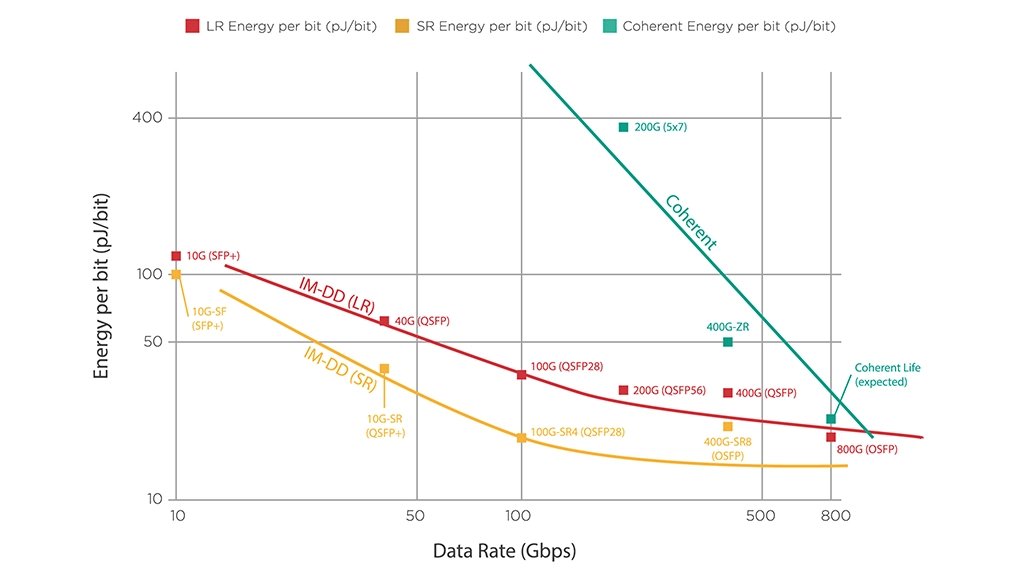Towards the 800ZR Future
The advances in electronic and photonic integration allowed coherent technology for metro DCIs to be miniaturized into QSFP-DD and OSFP form factors. This progress allowed the Optical Internetworking Forum (OIF) to create the 400ZR and ZR+ standards for 400G DWDM pluggable modules.
Following the success of 400ZR standardization, the industry quickly recognized the need for even higher-capacity solutions. In December 2020, the Optical Internetworking Forum (OIF) announced the initiation of the 800G Coherent project. This project aimed to define interoperable 800 Gbps coherent line specifications for various applications, including amplified DWDM links up to 120 km and unamplified fixed wavelength links of 2-10 km.
After the success of 400ZR standardization, the data center industry and the OIF are starting to promote an 800ZR standard to enable the next generation of interconnects. In OFC 2024, we started seeing some demos from several vendors and the OIF on this new standards initiative.
Coherent or Direct Detect for Data Centers
While coherent technology has become the dominant one for interconnecting data centers over long distances (80 km upwards), the campus sector and the inside of the data center continue to be dominated by direct detection technologies such as PAM-4.
However, as data rates rise into 800Gbps and beyond, the power consumption of coherent technology is expected to come much closer to that of direct detect PAM-4 solutions, as shown in the figure below. This can make coherent technology competitive for campus interconnects while direct detect technology remains dominant inside the data center.

A major reason for this decreased gap is that direct detect technology often requires additional amplifiers and compensators at these data rates, while coherent pluggables do not. This also makes coherent technology simpler to deploy and maintain. Furthermore, as the volume of coherent transceivers produced increases, their prices can also go down.
While the 800ZR standard is focused on longer-distance metro interconnects, efforts have also been made to develop a coherent 800G short-reach(SR) standard. Even if these efforts are unsuccessful in this generation of transceivers, they can lay the groundwork for using coherent technology in short-reach once terabit links become the new standard.
The Challenge of Power
LightCounting forecasts significant growth in dense-wavelength division multiplexing (DWDM) port shipments with data rates of 600G, 800G, and beyond in the next five years.

The major obstacles in this roadmap remain transceivers’ power consumption, thermal management, and affordability. Over the last two decades, power ratings for pluggable modules have increased as we moved from direct detection to more power-hungry coherent transmission: from 2W for SFP modules to 3.5 W for QSFP modules and now to 14W for QSSFP-DD and 21.1W for OSFP form factors. Rockley Photonics researchers estimate that a future electronic switch filled with 800G modules would draw around 1 kW of power just for the optical modules.
Thus, many incentives exist to improve pluggable optical transceivers’ performance and power consumption. By embracing increased photonic integration, co-designed PICs and DSPs, and more compact lasers, pluggables will be better able to scale in data rates while remaining affordable and low-power.
What Does This Mean for Lasers and DSPs?
The new generation of 800ZR pluggable transceivers can leverage 5nm process technology for their digital signal processors (DSPs), offering significant advancements over the 7nm technology used in 400ZR transceivers. A primary difference between these two processes lies in the size of the transistors used to build the chips: the 5nm process technology uses smaller transistors than the 7nm process. This size reduction allows more transistors to be packed into the same silicon area, enhancing the chip’s performance and energy efficiency.
For example, this enhanced transistor density facilitates higher baud rates, a critical factor for data transmission. The 800ZR modules will operate at baud rates of 120 GBaud, which doubles the 60 GBaud used in 400ZR transceivers. The increased power efficiency also makes these 800ZR transceivers more suitable for data center environments.
Regarding lasers for 800ZR, the mandate continues to be the same as always: develop the most powerful laser possible with the smallest footprint. Since 800G transmission naturally leads to higher transmission losses than 400G transmission, higher laser power is necessary to compensate for these losses and achieve the required reach. Meanwhile, the smaller laser size helps with thermal management inside the 800ZR module, and high laser power provides a higher link budget.
Takeaways
Following the success of the 400ZR standard, the Optical Internetworking Forum (OIF) quickly moved on to developing 800ZR standards for data center interconnects. The deployment of 800ZR technology promises substantial bandwidth and system performance enhancements but also poses a sustainable solution to the escalating power and thermal challenges modern data centers face. The use of 5nm process technology for DSPs and small but high-performance lasers within these modules will be vital to achieve the required power efficiency and performance.
